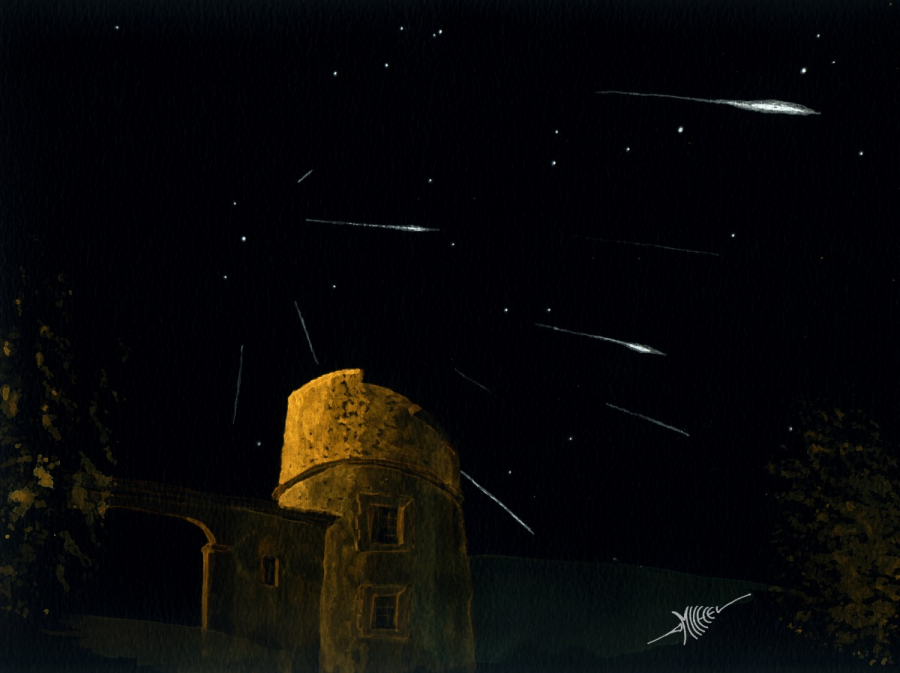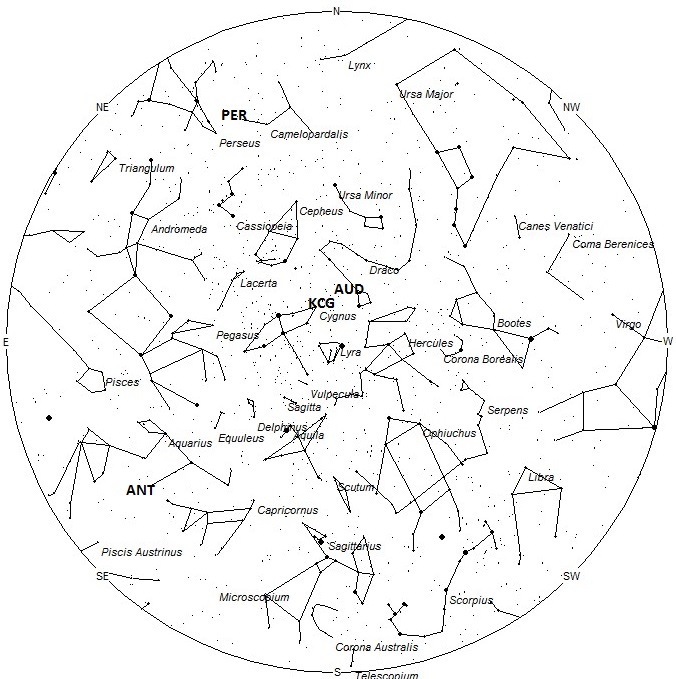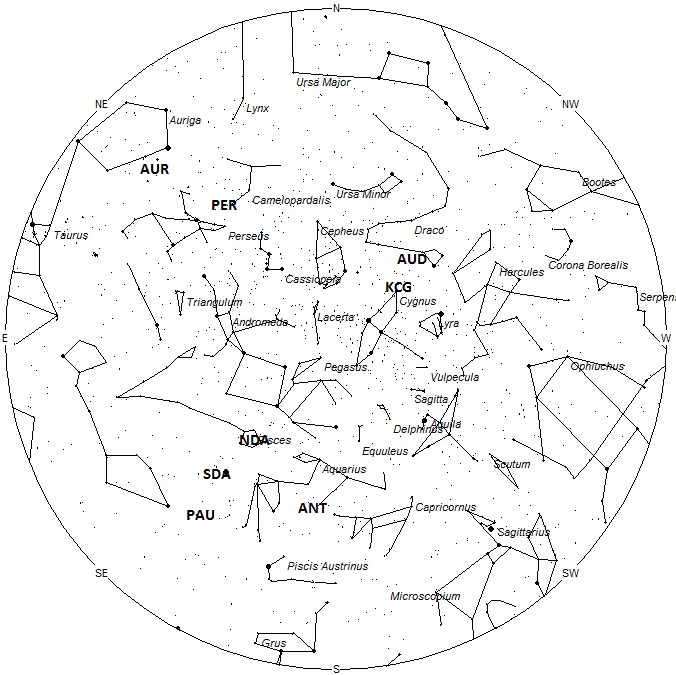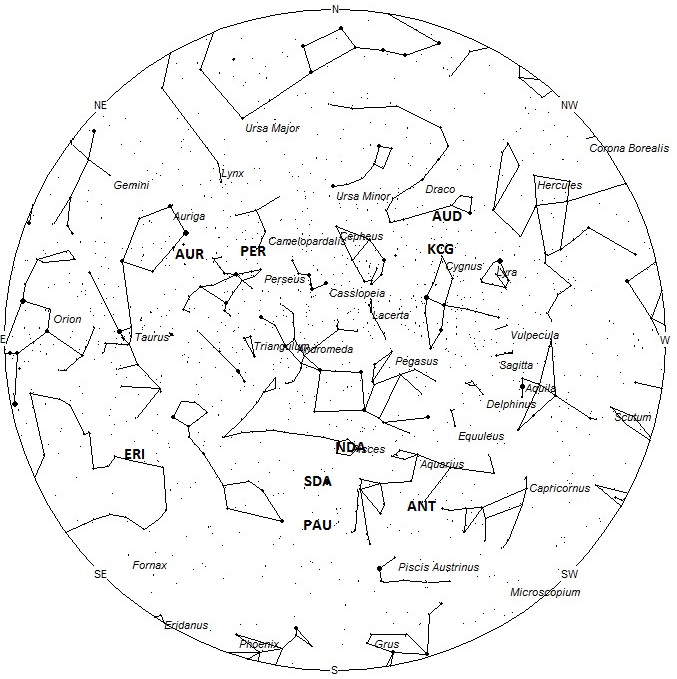
During this period the moon wanes from its full phase to nearly half illuminated. This weekend the waning gibbous moon will rise during the early evening hours and will compromise the sky the remainder of the night. This is the worst time of the month to try and view meteor activity as the more active morning hours are completely swamped in bright moonlight. The estimated total hourly meteor rates for evening observers this week is near 3 for those viewing from the northern hemisphere and 2 for those located south of the equator. For morning observers the estimated total hourly rates should be near 13 as seen from mid-northern latitudes (45N) and 6 as seen from tropical southern locations (25S). The actual rates will also depend on factors such as personal light and motion perception, local weather conditions, alertness and experience in watching meteor activity. Rates are reduced during this period due to moonlight. Note that the hourly rates listed below are estimates as viewed from dark sky sites away from urban light sources. Observers viewing from urban areas will see less activity as only the brightest meteors will be visible from such locations.
The radiant (the area of the sky where meteors appear to shoot from) positions and rates listed below are exact for Saturday night/Sunday morning August 17/18. These positions do not change greatly day to day so the listed coordinates may be used during this entire period. Most star atlases (available at science stores and planetariums) will provide maps with grid lines of the celestial coordinates so that you may find out exactly where these positions are located in the sky. A planisphere or computer planetarium program is also useful in showing the sky at any time of night on any date of the year. Activity from each radiant is best seen when it is positioned highest in the sky, either due north or south along the meridian, depending on your latitude. It must be remembered that meteor activity is rarely seen at the radiant position. Rather they shoot outwards from the radiant so it is best to center your field of view so that the radiant lies at the edge and not the center. Viewing there will allow you to easily trace the path of each meteor back to the radiant (if it is a shower member) or in another direction if it is a sporadic. Meteor activity is not seen from radiants that are located below the horizon. The positions below are listed in a west to east manner in order of right ascension (celestial longitude). The positions listed first are located further west therefore are accessible earlier in the night while those listed further down the list rise later in the night.
These sources of meteoric activity are expected to be active this week.
.
Rates and positions are exact for Saturday night/Sunday. Details of each source will continue next week when viewing conditions improve.
| SHOWER | DATE OF MAXIMUM ACTIVITY | CELESTIAL POSITION | ENTRY VELOCITY | CULMINATION | HOURLY RATE | CLASS |
| RA (RA in Deg.) DEC | Km/Sec | Local Daylight Saving Time | North-South | |||
| August Draconids (AUD) | Aug 16 | 18:08 (272) +59 | 21 | 22:00 | <1 – <1 | IV |
| kappa Cygnids (KCG) | Aug 14 | 19:12 (288) +54 | 21 | 23:00 | <1 – <1 | II |
| Anthelion (ANT) | – | 22:32 (338) -09 | 30 | 02:00 | 1 – 1 | II |
| Northern delta Aquariids (NDA) | Aug 14 | 23:24 (351) +04 | 38 | 03:00 | <1 – 1 | IV |
| Southern Delta Aquariids (SDA) | Jul 30 | 23:54 (359) -09 | 41 | 04:00 | <1 – <1 | I |
| Piscids Austrinids (PAU) | Aug 09 | 00:08 (002) -17 | 44 | 04:00 | <1 – <1 | II |
| eta Eridanids (ERI) | Aug 11 | 03:20 (050) -10 | 67 | 07:00 | 1 – 1 | IV |
| Perseids (PER) | Aug 13 | 03:41 (055) +59 | 59 | 07:00 | 5 – 1 | I |
| Aurigids (AUR) | Sep 01 | 04:54 (074) +39 | 66 | 08:00 | <1 – <1 | III |
| zeta Cancrids (ZCA) | Sep 03 | 08:06 (121) +15 | 42 | 11:00 | <1 – <1 | IV |
 American Meteor Society
American Meteor Society



Thank you this is quite helpful And informative
Was about 2:00 a.m. August 19th 2019 and I saw probably the biggest meteor shoot across the sky I have ever seen. Made me drop my jaw. One of the coolest things I had ever seen. Did you see it?
My husband saw it to, he said he thought it was around 1:40am, we live in upstate NY
We are in the UK. We were is Osmington weymouth dorset on Tuesday the 22nd August 2019 at around 10.15pm gmt. We saw a huge meteor that came from the direction of Cassiopeia and went towards the direction of Saturn. It was the biggest we have ever seen! We could see two clear sides of its tail burning almost across the whole sky. It was bright red….amaaaaaazing!!